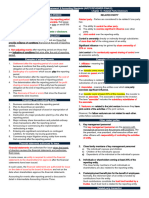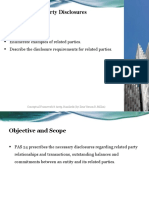0 ratings0% found this document useful (0 votes)
26 viewsChapter 4 - Related Parties
Chapter 4 - Related Parties
Uploaded by
clarizaThe document discusses related parties and related party transactions. Related parties include people or entities that have control or significant influence over the reporting entity. Disclosures are required about related party relationships and transactions, including transaction amounts and outstanding balances. Key management personnel and their compensation must also be disclosed.
Copyright:
© All Rights Reserved
Available Formats
Download as DOCX, PDF, TXT or read online from Scribd
Chapter 4 - Related Parties
Chapter 4 - Related Parties
Uploaded by
clariza0 ratings0% found this document useful (0 votes)
26 views2 pagesThe document discusses related parties and related party transactions. Related parties include people or entities that have control or significant influence over the reporting entity. Disclosures are required about related party relationships and transactions, including transaction amounts and outstanding balances. Key management personnel and their compensation must also be disclosed.
Original Description:
Notes for Related Parties
Copyright
© © All Rights Reserved
Available Formats
DOCX, PDF, TXT or read online from Scribd
Share this document
Did you find this document useful?
Is this content inappropriate?
The document discusses related parties and related party transactions. Related parties include people or entities that have control or significant influence over the reporting entity. Disclosures are required about related party relationships and transactions, including transaction amounts and outstanding balances. Key management personnel and their compensation must also be disclosed.
Copyright:
© All Rights Reserved
Available Formats
Download as DOCX, PDF, TXT or read online from Scribd
Download as docx, pdf, or txt
0 ratings0% found this document useful (0 votes)
26 views2 pagesChapter 4 - Related Parties
Chapter 4 - Related Parties
Uploaded by
clarizaThe document discusses related parties and related party transactions. Related parties include people or entities that have control or significant influence over the reporting entity. Disclosures are required about related party relationships and transactions, including transaction amounts and outstanding balances. Key management personnel and their compensation must also be disclosed.
Copyright:
© All Rights Reserved
Available Formats
Download as DOCX, PDF, TXT or read online from Scribd
Download as docx, pdf, or txt
You are on page 1of 2
Chapter 4: ii.
One entity is an associate or joint venture of the other
RELATED PARTIES entity (or an associate or joint venture of a member of a
group of which the other entity is a member).
iii. Both entities are joint ventures of the same third party.
Chapter Objectives:
iv. One entity is a joint venture of a third entity and the other
To understand the concept of related parties
entity is an associate of the third entity.
To identify related parties
v. The entity is a post-employment defined benefit plan for
To know the requirements for disclosure of related party
the benefit of employees of either the reporting entity or
relationship.
an entity related to the reporting entity. If the reporting
To know the requirements for disclosure of related party
entity is itself such a plan, the sponsoring employers are
transactions.
also related to the reporting entity.
vi. The entity is controlled or jointly controlled by a person
identified in (a).
RELATED PARTIES (PAS 24)
vii. A person identified in (i) has significant influence over the
entity or is a member of the key management personnel of
Objective of PAS 24
the entity (or of a parent of the entity).
The objective of IAS 24 is to ensure that an entity's financial
viii. The entity, or any member of a group of which it is a part,
statements contain the disclosures necessary to draw attention to
provides key management personnel services to the
the possibility that its financial position and profit or loss may
reporting entity or to the parent of the reporting entity*.
have been affected by the existence of related parties and by
transactions and outstanding balances with such parties.
The following are deemed not to be related:
Who are related parties?
A related party is a person or entity that is related to the entity
two entities simply because they have a director or key
that is preparing its financial statements (referred to as the
manager in common
'reporting entity').
two venturers who share joint control over a joint venture
providers of finance, trade unions, public utilities, and
a) A person or a close member of that person's family is related
departments and agencies of a government that does not
to a reporting entity if that person:
control, jointly control or significantly influence the
i. has control or joint control over the reporting entity;
reporting entity, simply by virtue of their normal dealings
ii. has significant influence over the reporting entity; or
with an entity (even though they may affect the freedom
iii. is a member of the key management personnel of the
of action of an entity or participate in its decision-making
reporting entity or of a parent of the reporting entity.
process)
a single customer, supplier, franchiser, distributor, or
b) An entity is related to a reporting entity if any of the following
general agent with whom an entity transacts a significant
conditions applies:
volume of business merely by virtue of the resulting
i. The entity and the reporting entity are members of the
economic dependence
same group (which means that each parent, subsidiary
and fellow subsidiary is related to the others).
What are related party transactions?
A related party transaction is a transfer of resources, services, or about the transactions and outstanding balances necessary for an
obligations between related parties, regardless of whether a price understanding of the potential effect of the relationship on the
is charged. financial statements. These disclosure would be made separately
for each category of related parties and would include:
Disclosure the amount of the transactions
Relationships between parents and subsidiaries. Regardless of the amount of outstanding balances, including terms and
whether there have been transactions between a parent and a conditions and guarantees
subsidiary, an entity must disclose the name of its parent and, if provisions for doubtful debts related to the amount of
different, the ultimate controlling party. If neither the entity's outstanding balances
parent nor the ultimate controlling party produces financial expense recognized during the period in respect of bad or
statements available for public use, the name of the next most doubtful debts due from related parties
senior parent that does so must also be disclosed.
Management compensation. Examples of the kinds of transactions that are disclosed if
Disclose key management personnel compensation in total and for they are with a related party
each of the following categories: purchases or sales of goods
purchases or sales of property and other assets
short-term employee benefits rendering or receiving of services
post-employment benefits leases
other long-term benefits termination benefits transfers of research and development
share-based payment benefits transfers under license agreements
transfers under finance arrangements (including loans and
Key management personnel are those persons having equity contributions in cash or in kind)
authority and responsibility for planning, directing, and controlling provision of guarantees or collateral
the activities of the entity, directly or indirectly, including any commitments to do something if a particular event occurs
directors (whether executive or otherwise) of the entity. or does not occur in the future, including executory
contracts (recognized and unrecognized)
If an entity obtains key management personnel services from settlement of liabilities on behalf of the entity or by the
a management entity, the entity is not required to disclose the entity on behalf of another party
compensation paid or payable by the management entity to the
management entity’s employees or directors. A statement that related party transactions were made on terms
equivalent to those that prevail in arm's length transactions should
Instead the entity discloses the amounts incurred by the entity be made only if such terms can be substantiated.
for the provision of key management personnel services that are
provided by the separate management entity*.
-End of Discussion-
Related party transactions.
If there have been transactions between related parties, disclose
the nature of the related party relationship as well as information
You might also like
- MFRS 124 Related Party Disclosure (RPD)Document3 pagesMFRS 124 Related Party Disclosure (RPD)NURUL FAEIZAH BINTI AHMAD ANWAR / UPMNo ratings yet
- PAS 24: Related Party Disclosures: ObjectiveDocument3 pagesPAS 24: Related Party Disclosures: Objectivepanda 1No ratings yet
- Conceptual Framework PAS 1 With Answer KeyDocument11 pagesConceptual Framework PAS 1 With Answer KeyRichel Armayan67% (21)
- Chapter 9 PAS 24 RELATED PARTY DISCLOSURES PAS 34 INTERIM FINANCIAL REPORTINGDocument5 pagesChapter 9 PAS 24 RELATED PARTY DISCLOSURES PAS 34 INTERIM FINANCIAL REPORTINGJeanette LampitocNo ratings yet
- Section 33Document12 pagesSection 33GetacherNo ratings yet
- IAS 24 - Related PartiesDocument3 pagesIAS 24 - Related PartiesJOEL VARGHESE CHACKO 2011216No ratings yet
- Fa 3 Chapter 4 Related PartiesDocument5 pagesFa 3 Chapter 4 Related PartiesKristine Florence TolentinoNo ratings yet
- Cfas Reviewer - 2ND SemDocument21 pagesCfas Reviewer - 2ND SemMĀKUKIRANNo ratings yet
- Related Party Disclosures: International Accounting Standard 24Document5 pagesRelated Party Disclosures: International Accounting Standard 24FateNo ratings yet
- Chapter 13 - Related Party DisclosuresDocument4 pagesChapter 13 - Related Party DisclosuresFerb CruzadaNo ratings yet
- Ias 24 Related PartyDocument4 pagesIas 24 Related Partyhassaanbinqudoos411No ratings yet
- CH 17 - Related Party DisclosuresDocument6 pagesCH 17 - Related Party DisclosuresJoyce Anne Garduque100% (1)
- Lecture 1 - MFRS 124 Related Party Revised 1Document20 pagesLecture 1 - MFRS 124 Related Party Revised 1Ho YingNo ratings yet
- Related Parties DisccussionDocument7 pagesRelated Parties DisccussionestesgadzNo ratings yet
- IAS 24 Related Party Disclosure - Study NotesDocument10 pagesIAS 24 Related Party Disclosure - Study Notescz82h7z84tNo ratings yet
- Module 7 Related PartiesDocument6 pagesModule 7 Related PartiesClarisse Erika EsmeriaNo ratings yet
- Financial Reporting Standard: This Standard Is Applicable For Annual Reporting Period Beginning On 1 January 2021Document12 pagesFinancial Reporting Standard: This Standard Is Applicable For Annual Reporting Period Beginning On 1 January 2021MuhammadAlwiNo ratings yet
- 1 RPTDocument2 pages1 RPTahmedfouad0712No ratings yet
- PAS 24 Related Party DisclosuresDocument2 pagesPAS 24 Related Party DisclosuresNikolai DanielovichNo ratings yet
- Week 10 Self Review Questions - Solns - Deegan - 9e - Ch23 - RPsDocument4 pagesWeek 10 Self Review Questions - Solns - Deegan - 9e - Ch23 - RPsjiejialing08No ratings yet
- Ias 24Document2 pagesIas 24Salman KhanNo ratings yet
- Related Party DisclosuresDocument8 pagesRelated Party DisclosuresramirezjohnkhalilNo ratings yet
- As 18Document18 pagesAs 18Harsh PatelNo ratings yet
- Unit Number/ Heading Learning Outcomes: Intermediate Accounting Iii (Ae 17) Learning Material: Related PartiesDocument5 pagesUnit Number/ Heading Learning Outcomes: Intermediate Accounting Iii (Ae 17) Learning Material: Related PartiesJhaylanie IgnacioNo ratings yet
- IAS 24 Related Party DisclosuresDocument9 pagesIAS 24 Related Party DisclosuresKanbiro OrkaidoNo ratings yet
- IAS 24 - Related Party Disclosures - Class NotesDocument7 pagesIAS 24 - Related Party Disclosures - Class NotesRobert lincolnNo ratings yet
- IAS 24-Related Party DisclosuresDocument27 pagesIAS 24-Related Party DisclosuresRiazboni100% (1)
- Pas 24 Related Party DisclosureDocument3 pagesPas 24 Related Party DisclosureR.A.No ratings yet
- Practical Guide: WWW - Pwc.co - UkDocument29 pagesPractical Guide: WWW - Pwc.co - UkDarmin Kaye PalayNo ratings yet
- IAS 24 - Related Party DisclosuresDocument5 pagesIAS 24 - Related Party DisclosuresTope JohnNo ratings yet
- Chapter 07 PAS 24 RELATED PARTY DISCLOSURESDocument4 pagesChapter 07 PAS 24 RELATED PARTY DISCLOSURESJoelyn Grace MontajesNo ratings yet
- Cofrac Finals ReviewerDocument2 pagesCofrac Finals Reviewervalenciaavegale03No ratings yet
- IAS 24 - Related PartiesDocument2 pagesIAS 24 - Related PartiestuuuhaNo ratings yet
- Related Party DisclosuresDocument11 pagesRelated Party Disclosuresaryanagrawal30662No ratings yet
- RR 19-2020 DigestDocument3 pagesRR 19-2020 Digestroldy22No ratings yet
- BSA 3202 Topic 2 - Joint ArrangementsDocument14 pagesBSA 3202 Topic 2 - Joint ArrangementsjenieNo ratings yet
- Ias 24Document7 pagesIas 24dustyal32No ratings yet
- FAR.2848 - Related Party Disclosures.Document4 pagesFAR.2848 - Related Party Disclosures.Christopher C. LegaspiNo ratings yet
- Related Party Transactions - ReadDocument86 pagesRelated Party Transactions - ReadUroobaShiekhNo ratings yet
- Objective of IAS 24Document2 pagesObjective of IAS 24Zes ONo ratings yet
- CFAS - Lec. 10 PAS 24 and 26Document13 pagesCFAS - Lec. 10 PAS 24 and 26latte aeriNo ratings yet
- International Accounting Standard-24: Related Party DisclosuresDocument19 pagesInternational Accounting Standard-24: Related Party DisclosuresBasavaraj S PNo ratings yet
- IAS 24 Presentation CPA JonathanDocument22 pagesIAS 24 Presentation CPA Jonathanrena chavezNo ratings yet
- #09 PAS 24 (Related Party Disclosures)Document3 pages#09 PAS 24 (Related Party Disclosures)Zaaavnn VannnnnNo ratings yet
- IAS 24-SlidesDocument10 pagesIAS 24-SlidesOhene Asare PogastyNo ratings yet
- INTACC 3.2LN - Related Party, Events After The Reporting Period, Operating SegmentsDocument5 pagesINTACC 3.2LN - Related Party, Events After The Reporting Period, Operating SegmentsAlvin BaternaNo ratings yet
- PAS 24 Related Party Disclosures: Learning ObjectivesDocument4 pagesPAS 24 Related Party Disclosures: Learning ObjectivesFhrince Carl Calaquian100% (1)
- Pas 24Document3 pagesPas 24AnneNo ratings yet
- IAS 24 Related Party Disclosures: Technical SummaryDocument3 pagesIAS 24 Related Party Disclosures: Technical SummaryFahreza DhikaNo ratings yet
- IAS 24 Related Party DisclosuresDocument3 pagesIAS 24 Related Party DisclosuresAKNo ratings yet
- Ias 24Document2 pagesIas 24Foititika.netNo ratings yet
- Nepal Accounting Standard 24: Related Party DisclosuresDocument9 pagesNepal Accounting Standard 24: Related Party DisclosuresSandeep GyawaliNo ratings yet
- FAR.2948 - Related Party DisclosuresDocument3 pagesFAR.2948 - Related Party DisclosuresEdmark LuspeNo ratings yet
- 74907bos60524 cp10 U1Document36 pages74907bos60524 cp10 U1chandrakantchainani606No ratings yet
- PAS 24 - RELATED PARTY DISCLOSURES LectureDocument12 pagesPAS 24 - RELATED PARTY DISCLOSURES LectureMon Ram100% (1)
- Ma Kyc Whitepaper Beneficial Ownership LOWRESDocument11 pagesMa Kyc Whitepaper Beneficial Ownership LOWRESactiktokukNo ratings yet
- Related Party Transactions PolicyDocument8 pagesRelated Party Transactions PolicyCamille FloresNo ratings yet
- Conflict of Interest PolicyDocument6 pagesConflict of Interest PolicyharshwardhanvyomkeshNo ratings yet
- Related PartiesDocument24 pagesRelated PartiesEsther PumihicNo ratings yet
- A Treatise on Indian Transfer Pricing Regulations - Part II: A Treatise on Indian Transfer Pricing Regulations, #2From EverandA Treatise on Indian Transfer Pricing Regulations - Part II: A Treatise on Indian Transfer Pricing Regulations, #2No ratings yet
- Partnership Dissolution ProblemsDocument2 pagesPartnership Dissolution ProblemsclarizaNo ratings yet
- Chapter 4 - Fundamentals of AccountingDocument16 pagesChapter 4 - Fundamentals of AccountingclarizaNo ratings yet
- Chapter 4 - Accounting FundamentalsDocument19 pagesChapter 4 - Accounting Fundamentalsclariza100% (1)
- Individual Income Tax ComputationsDocument13 pagesIndividual Income Tax ComputationsclarizaNo ratings yet
- Chapter 1Document18 pagesChapter 1clarizaNo ratings yet
- PROVISION - Contingent Liability: Start of DiscussionDocument2 pagesPROVISION - Contingent Liability: Start of DiscussionclarizaNo ratings yet
- Chapter 7 - Notes PayableDocument2 pagesChapter 7 - Notes PayableclarizaNo ratings yet
- Warranty Liability: Start of DiscussionDocument2 pagesWarranty Liability: Start of DiscussionclarizaNo ratings yet
- Notes To Financial Statements: Chapter ObjectivesDocument2 pagesNotes To Financial Statements: Chapter ObjectivesclarizaNo ratings yet
- Chapter 1 - Part 1Document2 pagesChapter 1 - Part 1clarizaNo ratings yet
- Chapter 1Document3 pagesChapter 1clarizaNo ratings yet
- 11 Individual P-WPS Office - 1Document35 pages11 Individual P-WPS Office - 1clarizaNo ratings yet
- Premium Liability: Start of DiscussionDocument3 pagesPremium Liability: Start of DiscussionclarizaNo ratings yet
- Installment Method - TaxDocument5 pagesInstallment Method - TaxclarizaNo ratings yet
- The New Companies & Business Entities Act - Short Notes & CommentsDocument10 pagesThe New Companies & Business Entities Act - Short Notes & CommentsLuke MadzikotoNo ratings yet
- Pedrollo JSWM JSW Cenovnik Elektrodjurovic Samousisne Centrifugalne Pumpe Za Vodu 2023Document1 pagePedrollo JSWM JSW Cenovnik Elektrodjurovic Samousisne Centrifugalne Pumpe Za Vodu 2023Andrej KurtekNo ratings yet
- How Bill Hwang of Archegos Capital Lost $20 Billion in Two Days - Bloomberg (VG)Document14 pagesHow Bill Hwang of Archegos Capital Lost $20 Billion in Two Days - Bloomberg (VG)OUSSAMA NASRNo ratings yet
- Data Management Concepts: 2013 Pearson Education, Inc. Publishing As Prentice Hall, AIS, 11/e, by Bodnar/HopwoodDocument57 pagesData Management Concepts: 2013 Pearson Education, Inc. Publishing As Prentice Hall, AIS, 11/e, by Bodnar/HopwoodDiva SabillahNo ratings yet
- INARI 28 Dec 2023 - Financial - Analysis - Explained - V1.1Document36 pagesINARI 28 Dec 2023 - Financial - Analysis - Explained - V1.1sj7953No ratings yet
- Duties of An AdvocateDocument11 pagesDuties of An Advocatesimran pathanNo ratings yet
- Structural Steel and Pipe Work ProcedureDocument5 pagesStructural Steel and Pipe Work ProcedureMohamed100% (2)
- Tax Advice Now at Your Finger TipsDocument3 pagesTax Advice Now at Your Finger TipsAbdelmadjid djibrineNo ratings yet
- Strategy Implementation: DirectingDocument14 pagesStrategy Implementation: DirectingCPANo ratings yet
- Graduate Attributes For MBADocument2 pagesGraduate Attributes For MBAsandeep kumarNo ratings yet
- Unit 12 Progress TestDocument2 pagesUnit 12 Progress TestPressCall AcademyNo ratings yet
- AI and Firm PerformanceDocument18 pagesAI and Firm PerformancesatthgurujiNo ratings yet
- Shri Ratan TataDocument10 pagesShri Ratan Tatasnhkmnkk4jNo ratings yet
- MWG Annual Report 2021Document208 pagesMWG Annual Report 2021Ngọc NguyễnNo ratings yet
- Bar Graph Unit MonthDocument2 pagesBar Graph Unit MonthSupreet SadashivNo ratings yet
- Indian Income Tax Return Assessment Year 2021 - 22: SugamDocument9 pagesIndian Income Tax Return Assessment Year 2021 - 22: SugamAvnish BhasinNo ratings yet
- Iso 45001 Iosh Presentation Apr 18Document18 pagesIso 45001 Iosh Presentation Apr 18Joséchu AnadónNo ratings yet
- M4 - IIFT Interview Transcripts (19-21)Document92 pagesM4 - IIFT Interview Transcripts (19-21)Ayush BeryNo ratings yet
- ISEB Foundation Certification in Software Testing CourseDocument1 pageISEB Foundation Certification in Software Testing CoursepeddikuppaNo ratings yet
- Bringing Kaizen To The Classroom: Lessons Learned in An Operations Management CourseDocument26 pagesBringing Kaizen To The Classroom: Lessons Learned in An Operations Management CourseStephanie SuarezNo ratings yet
- Privilege Access Levels CiscoDocument3 pagesPrivilege Access Levels CiscoANGEL GuzmanNo ratings yet
- Partnership Operation Practice Problems PDFDocument11 pagesPartnership Operation Practice Problems PDFMeleen TadenaNo ratings yet
- Manage Invoice Options - US1 Business UnitDocument2 pagesManage Invoice Options - US1 Business UnitI'm RangaNo ratings yet
- CRY Annual Report 2019 20Document41 pagesCRY Annual Report 2019 20OmkkarNo ratings yet
- Microeconomics 2023 BisDocument223 pagesMicroeconomics 2023 BisEsam IphoNo ratings yet
- BSP Manual On Foreign ExchangeDocument97 pagesBSP Manual On Foreign ExchangeJude ItutudNo ratings yet
- Case Study FordDocument29 pagesCase Study FordBasu100% (3)
- Part 3Document62 pagesPart 3Lan AnhNo ratings yet
- Fine Scale Modeler 2024-05-06Document60 pagesFine Scale Modeler 2024-05-06marcelloararipe0100% (1)







































































































